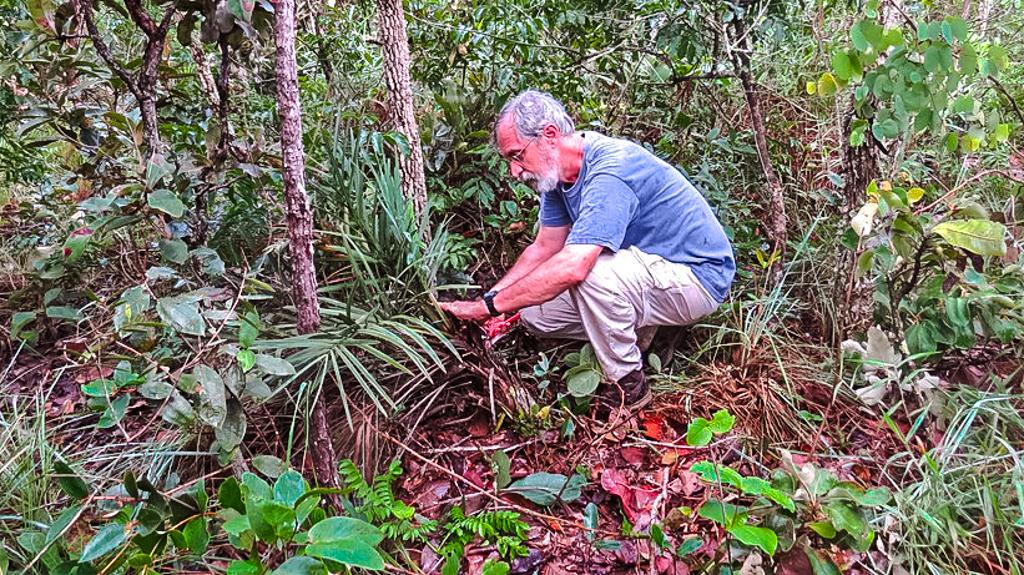The IPS fully supports the conservation of palm biodiversity and indigenous knowledge. Through its quarterly journal, PALMS, its website and through grants to individuals from the Endowment Fund, the IPS furthers education and research-based conservation. PALMS regularly features articles highlighting palm conservation needs and documenting indigenous knowledge. The IPS is aware of the threats to palms from habitat loss, climate change, over-exploitation and invasive species. The IPS recognizes the need for conservation at both the species and habitat levels and for ex situ conservation through horticulture.

Larry Noblick, Montgomery Botanical Center, identifying new Syagrus species in Brazil.
The 2500 or so species of palms face an uncertain future. We expect global climate change to affect their distributions and survival, but the most serious threats to wild palms arise from the direct activities of man, particularly deforestation and land conversion. As the human population increases, pressure on remaining natural vegetation becomes ever greater. It is ironic, perhaps, that one of the greatest threats to the survival of palm diversity in the humid tropics comes from a palm, the African Oil Palm, which is the most efficient vegetable oil-producing crop in the tropics. The dramatic expansion of oil palm cultivation has been responsible for the disappearance of vast swathes of tropical rain forest, the very habitat that is home to the greatest diversity of palms. Even within protected areas, palms are rarely safe; such reserves, often established to protect iconic animals, appear to provide sanctuary for palms, but often local people continue to fell palms within protected areas for the edible palm heart or for other palm products. Palms left in pastures appear to be safe, but careful study often reveals that no seedlings are present to replace the aging adults. Insect pests, spread from one area to another on landscape materials, are wreaking havoc in gardens and jumping to nearby natural areas, where they are attacking wild palms.

Oil Palm plantation, Costa Rica.
What can the IPS do? The IPS, by its charter, is committed to playing an active role in the conservation of palms. Crucial to saving palm diversity from extinction is baseline information on the distribution of wild palms. The IPS funds palm exploration, the results of which are usually published in our journal, PALMS. Such research has uncovered new species of palm and extended the known distribution of others. The IPS has also funded careful research into the genetic variability of endangered palms, research that provides crucial data for the conservation action plans for individual species.

IPS Grant recipient Roxaneh Khorsand, ascending Mauritia flexuosa in Brazil.
The cultivation of endangered palms in public and private collections has also an important role in the survival of palm diversity, although the ultimate goal of our efforts should be the survival of species in their natural habitats. The collection of palm seeds for cultivation almost always requires collection and export permits. Where conducted responsibly, such seed-collecting can benefit local people and satisfy the demand for rare and unusual palms. Fine examples of such responsibly collected seeds are the Vanuatu palm Carpoxylon macrospermum and the extraordinary Madagascar Tahina spectabilis, where the funds from the sale of seed were returned to the local community, thus providing a disincentive to destruction of the palms and encouragement for their protection.
What can you do?
You can join the IPS in conserving palms. Your annual membership ensures that the IPS can continue funding research and educational projects that contribute to conservation around the world. Want to do more? You can donate to the IPS conservation by clicking on the Donate Now button at the top of this page. The IPS is supported conservation of the Nature Conservancy’s Kona Hema Preserve on the island of Hawai’i, which his home to the endangered palm Pritchardia schattaueri. As the conservation funds grow, the IPS will partner with other organizations to conserve even more palms.
Want to do a just little more? Help promote the IPS’ work and spread the word on social media, your place of business, and among your friends.
